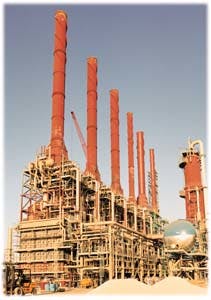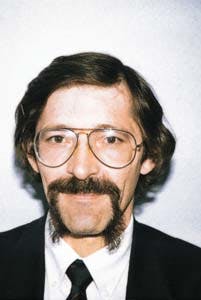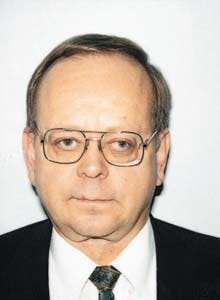Saleh M. Al-Halaki
Qapco Petrochemical Co. Ltd.
Mesaieed, QatarJean-Paul Laugier, Gérard Heck
Technip
Paris
In the cracking-furnace area, the four front stacks belong to seven older furnaces, each with an ethylene capacity of 50,000 tons/year. The two rear stacks are part of three new furnaces, a capacity of 90,000 tons/year, added during the expansion projectQatar Petrochemical Co. (Qapco) expanded its Mesaieed, Qatar, ethane cracker in 1996 to accommodate increased ethane availability from the North field project.
Qapco is owned by Qatar General Petroleum Corp. (80%), Elf Atochem (10%), and Enichem SpA (10%).
This $125 million project was engineered and constructed by Technip Group, Paris. Technip used its systematic approach to modernization (SAM) to minimize equipment replacement, capital investment, and construction duration in the project execution.
The new plant has a production capacity of 540,000 tons/year, a 78% capacity increase. Moreover, plant performance has improved. The ethylene recovery rate is 99.8%, and the energy consumption has been reduced by 30%.
Plant background
The Qapco ethane cracker was the first steam cracker in the Middle East when it came onstream in 1980 (OGJ, Apr. 6, 1981, p. 79). The grassroots cracker was originally designed for a capacity of 280,000 tons/year of polymer-grade ethylene. The cracker complex included:- Upstream units for ethane-feedstock production from associated gas (ethane-rich gas)
- Downstream units for sulfur production (50,000 tons/year) and polyethylene production (140,000 tons/year)
- A utilities center
- A storage area for ethane, ethylene, propylene, and sulfur as well as loading facilities for ethylene import and export.
During the 1980s, oil production at Qatar was reduced, and the complex ran at about 50% of its capacity as a result of an ethane-rich gas shortage. In 1984, Qapco added a second ethane-recovery unit (ERU) to secure feed for the cracker. This unit was fed by an ethane-lean gas from a neighboring pipeline. The new ERU, designed and built by Technip, was integrated within the existing facilities at Mesaieed.
After 1988, the ethane cracker ran at design capacity. Fig. 1 [74,170 bytes] tracks Qapco's ethylene production from 1981 to 1997.
The start-up of the North field natural gas project in the early 1990s made more ethane-rich gas available. It was then possible to run the first ERU at full capacity. With more ethane feedstock available than needed, Qapco sought to expand the existing ethane cracker.
Although the ethylene cracker at that time was designed for 280,000 tons/year, it had actually produced 357,000 tons/year of ethylene in 1994. This high production was possible as a result of an exceptionally long onstream period (8,500 hr) and good optimization in 1994.
As a result of Technip's feasibility study, Qapco decided to increase the cracker capacity to 540,000 tons/year.
Feasibility study
Qapco sought lump-sum bids for the expansion of the cracker. In the first phase, Qapco looked for a feasibility study that identified stepwise capacity steps for the cracker debottleneck with corresponding investment costs and production costs associated with the additional ethylene output.Technip proposed the SAM concept to modernize the ethylene plant. SAM is based on three interdependent targets (Fig. 2 [86,275 bytes]):
- Stepwise-capacity maximization
- Energy-demand minimization
- Investment-cost minimization.
Capacity maximization relates to equipment. To satisfy the capacity goals, existing equipment can be upgraded or replaced, or new equipment can be installed.
Energy-demand minimization is performed by optimizing process technology. Energy can be minimized by retrofitting the existing process scheme according to progressive-separation technology, to the results of an energy-value analysis, and to the results of a heat-network integration analysis.
The progressive-separation concept was developed by Technip and Elf for crude distillation in the early 1980s.1 According to this concept, a multicolumn scheme is the most efficient scheme to separate products from a multicomponent stream. Savings are realized by reduced energy and capital costs. The application of this concept to the cracked gas in an ethylene unit, also called distributed distillation, has been studied.2 3
Cost of equipment and schedule define the economics for each capacity goal. Table 1 [7,602 bytes] details the step-by-step activities during this project phase.
The different possible capacity choices identified during the feasibility study are shown in Fig. 3 [157,910 bytes]. The bar length represents the maximum production capacity given the major-limiting equipment.
A reference test run at a capacity of 304,000 tons/year was used as a basis for the expansion study. During the test run, the furnaces were the main debottleneck.
With new furnaces, the existing compressor limited the plant to 310,000 tons/year of ethylene production. Increased suction pressure provided by a new turbine, however, would allow production over 400,000 tons/year.
Any further capacity beyond 480,000 tons/year required replacement of the existing compressor with a new compressor with five stages and a booster. Having chosen this route, Qapco installed the first compression stage with a dedicated driver at grade. Stages 2-5 were installed on the existing structure and driven by the existing turbine.
The revamp of the second ERU achieved the final capacity goal of 540,000 tons/year.
Basic engineering
The second phase of the project, the basic engineering package, followed the feasibility study.During the contract-negotiation stage, Technip offered Qapco a unique approach to improve the project economics. Technip proposed designing and scheduling the project in such a way that the ethylene production was increased as early as possible. The capacity goal could be achieved later.
Based on this proposal, Technip was selected to execute the ethylene plant expansion project on a lump-sum, turnkey basis.
Technip proposed two separate shutdown periods to minimize the overall shutdown duration and to ensure early increased production. After the first shutdown, Technip claimed that the following three items would be accomplished:
- An early increase in ethane production
- The unloading of the ethane-cracker compression and fractionation sections, which would allow increased processing of ethane-cracking effluent
- A new furnace to crack the increased ethane production.
This process freed up the compression and fractionation sections to treat more ethane-cracking effluents. Consequently, this process increased net-ethylene production about 20,000 tons/year.
To secure early ethane production, one of the ERUs was revamped during the first shutdown. In addition, one new furnace (of three total furnaces) was ready to start production after the shutdown.
Because the cracker could process more ethane feedstock, ethylene production increased after the first shutdown.
Project scope
The lump-sum, turnkey contract was valued at about $125 million, or $500/ton of additional ethylene production. It included a new cracker and expansion of two ethane-production units.The engineering, procurement, and construction of the project were limited to 24 months, including two shutdowns. In any case, the second shutdown period of 5 weeks was required for normal plant maintenance. As a result of this approach, the production losses were limited to that corresponding with the first shutdown period of 3 weeks.
The two ethane-feed preparation units were debottlenecked. The first one, fed by ethane-rich gas, was expanded to produce 40% more ethane feedstock.
The second one, fed continuously by ethane-lean gas, was retrofitted to increase the ethane production by 30%. The ethane recovery rate increased from 78 to 94%. Here, Technip applied its Cryomax process, a patented cryogenic process to recover C2 and C3 hydrocarbons from natural gas, associated gas, or refinery-off gas via fractionation.
To minimize the cost of expansion of the utilities section (steam and electricity generation) and the expansion of the refrigerant-cycle compressors, the process scheme was retrofitted with the progressive-separation concept. This concept reduced the overall specific power consumption to 750 kw-hr/ton of ethylene production. This savings includes the refrigeration power for the feed-preparation units.
The ethylene-recovery rate has increased to 99.7% in the ethylene recovery section. As a result of the good performance of the cold box and the expanders, the ethylene losses in the fuel gas are only 0.1% of the ethylene production instead of the expected 0.35%. This ethylene recovery results in an additional 5,000 tons/year of ethylene.
Both new and existing equipment have been upgraded with new technologies:
- Distillation towers have high-efficiency/capacity trays or random/structured packing.
- Separation drums have high-efficiency separator devices.
- Some exchanger bundles have been replaced with UOP High-flux tube bundles for enhanced heat-transfer coefficients.
- Existing compressors were equipped with dry-gas seals to improve operability and maintenance.
- Existing reactors for acetylene hydrogenation have been filled with new catalyst loads that permit a higher space velocity.
A detailed Hazop review updated the plant's operability and safety systems to current standards.
Fig. 4 [101,050 bytes] illustrates the final process scheme of the Qapco ethylene project.
Revamp logistics
The Qapco expansion was constructed during plant operations except for two scheduled shutdown periods. The first shutdown lasted 3 weeks and occurred 12 months after the contract's effective date. The second shutdown lasted 5 weeks and occurred 12 months after the first shutdown. Fig. 5 [63,665 bytes] shows a schedule of the project expansion.Several difficulties were encountered during the construction phase. First, because 80% of the construction had to be done while the plant was in operation, several extreme safety measures were necessary:
- Up to 100 daily work permits were issued.
- The number of simultaneous hotwork permits was limited.
- Fixed fire-protection devices were required to perform hotwork.
Because the units were in operation, work was performed in restricted areas. Finally, hot (on-line) transfers to the DCS were required in a majority of the existing loops.
An overview of the amount of work performed is shown in Table 2 [12,991 bytes]. With the unit in operation, 78 new pieces of equipment were added. Table 3 [16,696 bytes] gives an idea of the technology used in the new equipment added during the expansion. Several new compressors and expanders were installed as part of the project:
- Cracked-gas compressor (first stage) with a back-pressure turbine driver
- Cracked-gas compressor (stages 2-5) with existing turbine
- Propylene-refrigerant compressor with an electric-motor driver
- Ethane-feed compressor with an electric-motor driver
- Light-ends gas expander (three stages with oil brakes) with a dry-gas seal
- Methane expander/compressor with magnetic bearings.
Operations
The philosophy of the expansion was to improve the operability and the onstream factor of the plant as much as possible. The original design onstream factor, 7,800 hr/year, was increased to 8,000 hr/year after the plant expansion.To meet this onstream factor, the equipment was purchased and arranged in such a way that in case of shutdown of major equipment, the loss to production is minimized. Mainly, the new compressors and expanders contribute to this goal. Table 4 [9,257 bytes] shows the level of production that Technip guarantees should specific equipment be shutdown.
After start-up, ethylene production began at the specified 48 hr after ethane input. The plant quickly demonstrated a capacity of 70.0 tons/hr, which corresponds to an annual capacity of 560,000 tons/year, exceeding the design capacity. The two ERUs integrated with the cracker have also reached guaranteed ethane-production rates.
Acknowledgment
The authors wish to thank Dr. Victor Kaiser, ethylene technology manager of Technip, for his contribution to development of the modernization methodology and his advice on the cryogenic processing scheme.References
- Kaiser, V., and Gourlia, P., "Apply exergy to distillation," Chemical Engineering, No. 17, 1985.
- Kaiser, V., and Picciotti, M., "Better ethylene separation unit," Hydrocarbon Processing, November 1988.
- Kaiser, V., and Picciotti, M.. "Separate ethylene efficiently," Hydrocarbon Processing, July 1991.
The Authors
Saleh M. Al-Halaki is ethylene superintendent at Qapco Petrochemical Co. Ltd. He has 10 years of experience at the petrochemical complex. As operation leader of the Qapco project, he was in charge of the project task force for the revamping, precommissioning, commissioning, and startup of the ethylene plant with Technip. He was also leader of the performance test after the project completion in July 1996.Al-Halaki holds a BS in chemical engineering from Qatar University.
Jean-Paul Laugier is a principal engineer with Technip in the process engineering department. He has more than 18 years of experience in Technip's process department. He was lead process engineer for the Qapco capacity expansion project.Laugier holds a masters degree in chemical engineering from ENSIC, Nancy, France.
Gérard Heck is a process-engineering department manager with Technip. He has 30 years of experience in process engineering. He was previously a chief-process engineer for ethylene technology.Heck holds a masters degree in chemical engineering from INSA, Lyon, France, and a masters of science degree in applied chemical engineering from IFP, Rueil Malmaison, France.
Copyright 1998 Oil & Gas Journal. All Rights Reserved.






